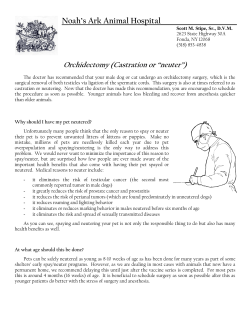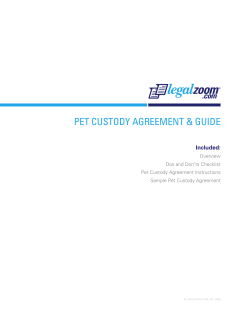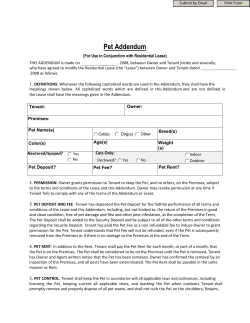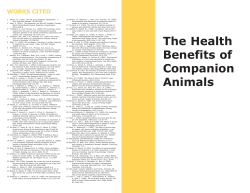
PET SITTING AGREEMENT & GUIDE Included: Overview
PET SITTING AGREEMENT & GUIDE Included: Overview Dos and Don’ts Checklist Pet Sitting Agreement Instructions Sample Pet Sitting Agreement © LEGALZOOM.COM, INC. 2008 1. Overview Pets (like humans) are most comfortable in their own homes. If you go away on a business trip or vacation, it’s important to make sure your absence is as stress-free for your animal as possible. Making sure your pets are in a familiar environment, with a stable food and exercise routine, is a safe and healthy way to allay their fears. Hiring a professional pet sitter allows you to take care of your pet safely and economically. A wellconstructed agreement protects both the owner and the sitter, making sure each party understands its rights and responsibilities in the arrangement. If you are a sitter, having this form ensures you get all of the information you need to take care of the pet in your charge. If you are an owner, this agreement provides assurance that your pet will get the care and attention it deserves. The enclosed document can provide a good starting point for your negotiations. The owner and the sitter must continue to discuss the terms of the agreement, settling questions about service obligations and payment. Once you have agreed on contract terms and have signed the attached form, you can both rest assured that you have an agreement to protect both party’s interests – and those of the pets as well. 2. Dos & Don’ts Checklist A pet sitter should provide the owner with proof that it is bonded against theft by any of its employees. Pet sitters regularly enter the homes of their clients, and thus can be held responsible for theft of any property that occurs during the term of the arrangement. Once it has been demonstrated that a criminal act has occurred, the bonding company will pay the owner and seek reimbursement from the party who committed the crime. A pet sitter bond can assure both parties that an owner’s property is protected from harm in his or her absence. A pet sitter should have proof of liability insurance (which should be provided to each pet owner client). There are general liability insurance policies specifically designed for sitters, which usually cover damage and injury to other people and other pets. Note that the proper amount of coverage will depend on the type and number of animals watched (e.g., show animal vs. family pet, horse vs. cat) and the length of time in care. Although most jurisdictions do not issue specific pet sitter licenses, the city or state you live in may require a pet sitter to obtain a general business license. If you are a sitter starting out in the profession, this is something to consider. Being caught doing business without a license may subject you to hefty fines. If you are hiring a pet sitter, check to see if that sitter has a business license in your area. This may seem like overkill for a simple job, but it’s a good way to check the stability and reliability of the company or person you’re hiring. Do your due diligence. If you’re an owner, you’re going to be leaving your pet (and your home) in the hands of the person or agency you select. Do they have a website listing their services, rates, policies, and contact information? Did they provide references with phone numbers? A little work up front could save you considerable time and money down the road. PET SITTING AGREEMENT © LEGALZOOM.COM, INC. 2008 1 Before leaving, provide your pet sitter with as much information as possible. This will reduce the likelihood of any misunderstandings and the frequency of phone calls asking for clarification. Consider preparing a list of the following (much of which is considered in the draft Exhibit D to the agreement): A description of the pet’s daily routine A list of any health problems and/or medications required by your pets Contact information for your veterinarian Contact information for other home maintenance workers (e.g., plumbers, electricians, etc.) Location of your pet’s favorite hiding places Location of your pet’s favorite toys Location of collar and leash, ID tags, pooper scoopers, litter boxes, cat litter and cleaning supplies, etc. Written verification of any and all vaccines that have been given to your pets Your contact information in your absence A list of any rooms that are off-limits to people or pets Location of cleaning and other household supplies Location of your fuse box and any new fuses, thermostat, main water shut-off valve, gas shut-off valve, fire extinguisher, etc. If possible, plan a meeting between the pets and the sitter before the owner leaves on his or her trip. This may make the actual departure less traumatizing on the animals and may lay a good foundation for the sitter-pet relationship. Do not assume that your pet sitter will take on house sitting duties (turning on lights in the evening and off in the morning, opening and closing curtains and blinds, watering plants, picking up newspapers and mail, etc.) if this is not spelled out in your agreement. If you are asking for additional services, you may be asked to pay more for the sitter’s time. Let your neighbors know that a pet sitter will be visiting your house while you are gone. This may prevent misunderstandings and confusion when an unfamiliar person is seen coming and going at your home. Allow each party to spend time reviewing the agreement and (once completed) the exhibits. This will reduce the likelihood, or at least the efficacy, of a claim that a party did not understand any terms or how those might affect the agreement as a whole. Both parties should review the completed agreement carefully to ensure that all relevant deal points have been included. It is better to be over-inclusive than under-inclusive. Do not assume that certain expectations or terms are agreed to if they are not stated expressly in the document. PET SITTING AGREEMENT © LEGALZOOM.COM, INC. 2008 2 For many reasons, it’s essential that a pet sitter be treated as an independent contractor, and not as an employee of the owner for which it works. If independent contractors are reclassified as employees, the owner using those contractors will be required to reimburse the IRS or state tax authority for delinquent employment taxes, interest, and penalties. A written agreement can provide some protection from these charges, but is only the first step in establishing an individual’s independent contractor status. Once signed, both parties must follow its terms exactly to make sure that status is maintained. Review your state’s laws governing independent contractors. In recent years, many states have made it difficult for individuals to qualify, imposing absolute requirements about the freedom a contractor must have from company control. Certain provisions in the enclosed agreement may need to be strengthened or adapted to fit your state’s rules. Sign two copies of the agreement, one for you and one for the other party. Keep your copy of the signed agreement for your records. At the end of its term, you and the other party can revisit its provisions and consider whether to renew. Depending on the nature of its terms, you may decide to have your agreement witnessed or notarized. This will limit later challenges to the validity of a party’s signature. If your agreement is complicated, do not use the enclosed form. Contact an attorney to help you draft a document that will meet your specific needs. 3. Pet Sitter Agreement Instructions The following provision-by-provision instructions will help you understand the terms of your agreement. The numbers below (e.g., Section 1, Section 2, etc.) correspond to provisions in the form. Please review the entire document before starting your step-by-step process. • Introduction. Identifies the document as a pet sitting agreement. Write in the date on which the agreement will become effective (often the date on which it is signed). Identify the parties and, if applicable, what type of organization(s) they are. The Agreement assumes that the Owner is an individual (i.e., not a corporation or other organization). If this is not the case, feel free to change this to better characterize the Owner. Note that each party is given a name (e.g., “Owner”) that will be used throughout the agreement. The pet owner is called the “Owner” and the pet sitter is called the “Sitter.” • Recitals. The “whereas” clauses, referred to as recitals, define the world of the agreement and offer key background information about the Parties. In this agreement, the recitals include a simple statement of your intent to enter into a pet sitting arrangement. Enter the name(s) of the pets that will be watched by the Sitter. If there is only one pet who will be the subject of this Agreement, replace all references to “pet(s)” in the document with “pet”; if there are multiple pets to be watched, delete the parentheses around the “s.” PET SITTING AGREEMENT © LEGALZOOM.COM, INC. 2008 3 • Section 1: Responsibilities. Lists each Party’s responsibilities under the Agreement. Essentially, the Sitter is agreeing to perform the agreed-on services with adequate attention and care, and the Owner is agreeing to assist in this performance by providing necessary information and guidance. You can feel free to delete any of the responsibilities that you do not want to require, or add additional items that are specific to your arrangement. • Section 2: Nature of Relationship. Explains that the Sitter is not an employee or partner of the Owner. This is an important distinction for legal reasons, including requirements of insurance coverage, liability, and taxes. The agreement seeks to emphasize this divide, but both parties should take care not to blur the line between independent contractor and employee in the performance of their duties. Review your state’s laws governing independent contractors to make sure that the enclosed agreement follows local restrictions. • Section 3: Representations and Warranties. Details the Parties’ promises under the Agreement. Each Party is agreeing to enter into the arrangement based on the conditions listed in this section (e.g., that each is capable of entering the agreement and satisfying its terms). The Sitter’s representations and warranties certify that it will be responsible for hiring any parties to do the work. The Owner’s representations and warranties are somewhat more detailed, and provide assurance to the Sitter that the Pets are not dangerous, and that emergency contacts are available if the Owner cannot be reached. • Section 4: Compensation. (a) Explains that the complete payment terms are detailed in Exhibit A. (b) Indicate the amount of time the Owner has to forward payments to the Sitter. If your arrangement is more casual, this does not need to be a detailed invoice; rather, it can be a simple report of the tasks performed and the rates applicable to that performance. (c) The circumstances under which no payments will be made. (d) Notes that except as stated specifically otherwise in the Agreement (e.g., payments for additional pet food or emergency expenses) the Sitter will pay for its own expenses in performing the Services. If the Parties want to more specifically define the types of expenses that will be paid by the Owner, they can do so in the blank space provided. Keep these exceptions limited if you choose to include them. If the Owner pays for all of the Sitter’s expenses, the relationship will be seen as more like that between an employer/employee than an independent contractor arrangement. (e) Indicates that the Sitter is responsible for paying its own taxes on the money it receives (i.e., it is not receiving a “salary” as an employee of the Owner and the Owner will not withhold those amounts on its behalf). • Section 5: Term. Indicates that the Agreement will last until termination or until either a specific end date or for a certain number of years. There are two options provided, and you should choose the one that best suits your arrangement. In the first, a long-term relationship is considered, and the Agreement is taken to endure indefinitely. There is an optional bracketed sentence at the end, which allows you to set a long-term deadline for the Agreement. If you select option 1 and do not want to set an expiration date for your agreement, you can delete the second bracketed phrase. The second option contemplates a one-time sitting arrangement, and allows you to enter a specific (and short-term) end date for the Agreement. Select the option that best suits your arrangement and delete the other. PET SITTING AGREEMENT © LEGALZOOM.COM, INC. 2008 4 • Section 6: Termination. Explains that certain actions or events, including written notice or material breach, will cause the Agreement to end out of time (i.e., before the services are completed or the end of the term, if any). Write in the amount of notice a Party must give of its intent to terminate or to notify the other of a breach. Pay particular attention to subsection (c), which allows the Sitter to terminate the Agreement at any time if the Pet(s) become violent or dangerous. In such cases, the Sitter can place the Pet(s) into a kennel or other agreed-on facility until the Owner can return and assume responsibility for the Pet(s). • Section 7: Authorization of Emergency Medical Care. Allows the Sitter to get emergency medical care for the Pet(s) in the Owner’s name during the Owner’s absence. This paragraph also promises that any costs incurred in such emergency care will be paid by the Owner. Note the references to the exhibits. Exhibit B is a list of emergency contact names (other than the Owner) and Exhibit C is a veterinarian release form allowing the Pet(s) to be treated during the Owner’s absence. Under the terms of this section, the Owner must fill out and sign the Release on or before the date the Agreement is signed. • Section 8: Indemnification. This provision allocates responsibilities between the parties if problems arise in the future and protects each Party from the consequences of the other’s negligent or intentional conduct. • Section 9: Exclusion of Liability. Specifies the items for which the Sitter will not be held liable or financially responsible. These items include any damage or destruction resulting from the Pet’(s) actions or health problems. Note that unless you agree in writing that the Sitter will also be responsible for house-related activities (e.g., watering plants, etc.), the Sitter is also excused from liability for any damages resulting from its failure to perform them. • Section 10: Modification. Indicates that any changes to the document are ineffective unless they are made in writing and signed by both Parties. • Section 11: Assignment. Explains that each Party must obtain the other’s written permission before assigning its obligations and interests. • Section 12: Successors and Assigns. States that the Parties’ rights and obligations will be passed on to heirs or, in the case of companies, successor organizations or organizations to which rights and obligations have been permissibly assigned. • Section 13: No Implied Waiver. Explains that if either Party allows the other to ignore or break an obligation under the agreement, it does not mean that Party waives any future rights to require the other to fulfill those (or any other) obligations. • Section 14: Notice. Lists the addresses to which all official or legal correspondence should be delivered. Write in a mailing address for both the Owner and the Sitter. • Section 15: Governing Law. Allows the Parties to choose the state laws that will be used to interpret the document. Note that this is not a venue provision. The included language will not impact where a potential claim can be brought. Write in the applicable state law in the blanks provided. • Section 16: Counterparts / Electronic Signatures. The title of this provision sounds complicated, but it is simple to explain. It says that even if the Parties sign the Agreement in different locations, or use electronic devices to transmit signatures (e.g., fax machines or computers), all PET SITTING AGREEMENT © LEGALZOOM.COM, INC. 2008 5 of the separate pieces will be considered part of the same agreement. In a modern world where signing parties are often not in the same city - much less the same room - this provision ensures that business can be transacted efficiently, without sacrificing the validity of the agreement as a whole. • Section 17: Severability. Protects the terms of the agreement as a whole, even if one part is later invalidated. For example, if a state law is passed prohibiting choice-of-law clauses, it will not undo the entire document. Instead, only the section dealing with choice of law would be invalidated, leaving the remainder of the agreement enforceable. • Section 18: Entire Agreement. The Parties’ agreement that the document they’re signing is “the agreement” about the issues involved. Unfortunately, the inclusion of this provision will not prevent a Party from arguing that other enforceable promises exist, but it will provide you some protection from these claims. • Section 19: Headings. Notes that the headings at the beginning of each section are meant to organize the document, and should not be considered operational parts of the note. • Exhibit A: Services, Specifications, and Compensation. The form of Exhibit A provided is meant as an example only. You and the other Party should restructure and revise this exhibit to fit your situation and individual needs. There are two types of compensation arrangements outlined in the form. You can choose either, or come up with a third structure better suited to your agreement. • Exhibit B: Emergency Contact List. Enter the names of at least three (3) emergency contacts that the Sitter can call during the Owner’s absence. • Exhibit C: Veterinary Release. It’s one thing to state in the Agreement that the Owner is giving its consent to emergency treatment. It’s another to offer direction to the veterinarian to give that treatment. This Exhibit C is a release that, once signed, should be given to the veterinarian in an emergency situation. It should be completed by the Owner before it leaves its Pets in the Sitter’s care. • Exhibit D: Pet(s) Information. This is an example of an information sheet that may be provided to a pet sitter. It asks for a broad range of information, and not every item will be applicable to every pet (or every arrangement). You can feel free to add or subtract items to suit your needs. Attach proof of the vaccinations received by each Pet, and the dates of those vaccinations. Include any additional health or other information you think may be helpful to the Sitter in performing its duties under this Agreement. DISCLAIMER LegalZoom is not a law firm. The information contained in the packet is general legal information and should not be construed as legal advice to be applied to any specific factual situation. The use of the materials in this packet does not create or constitute an attorney-client relationship between the user of this form and LegalZoom, its employees or any other person associated with LegalZoom. Because the law differs in each legal jurisdiction and may be interpreted or applied differently depending on your location or situation, you should not rely upon the materials provided in this packet without first consulting an attorney with respect to your specific situation. The materials in this packet are provided "As-Is," without warranty or condition of any kind whatsoever. LegalZoom does not warrant the materials' quality, accuracy, timeliness, completeness, merchantability or fitness for use or purpose. To the maximum extent provided by law, LegalZoom, it agents and officers shall not be liable for any damages whatsoever (including compensatory, special, direct, incidental, indirect, consequential, punitive or any other damages) arising out of the use or the inability to use the materials provided in this packet. PET SITTING AGREEMENT © LEGALZOOM.COM, INC. 2008 6 Form Sample PET SITTING AGREEMENT © LEGALZOOM.COM, INC. 2008 7
© Copyright 2025















